
by Fronetics | Oct 31, 2016 | Blog, Current Events, Strategy, Supply Chain
U.S. Consumers plan to spend a whopping $8.4 billion on costumes, candy, decorations, and more to celebrate Halloween 2016.
The National Retail Federation anticipates spending for Halloween 2016 will be at an all-time high.
The NRF’s annual survey found that 171 million Americans will celebrate the holiday, spending a total of $8.4 billion, the most reported in the survey’s 11-year history. Consumers plan to spend an average of $82.93 each, up from last year’s $74.34 per person spending.
As far as costumes go, NRF says to expect zombies, Minions, and characters from Star Wars and Disney’s Frozen to show up at your door. If you’re still looking for ideas yourself, try Pinterest, where 17% of consumers plan to get their inspiration for costumes this year.
Are you one of the 16% who will dress your pet up for Halloween? Take a note from last year’s top 5 pet costumes:
- Pumpkin
- Hot dog
- Batman character
- Devil
- Bumblebee
Check out our infographic of other interesting Halloween 2016 facts from the NRF’s survey of 6,791 consumers below.
Halloween 2016: A supply chain infographic
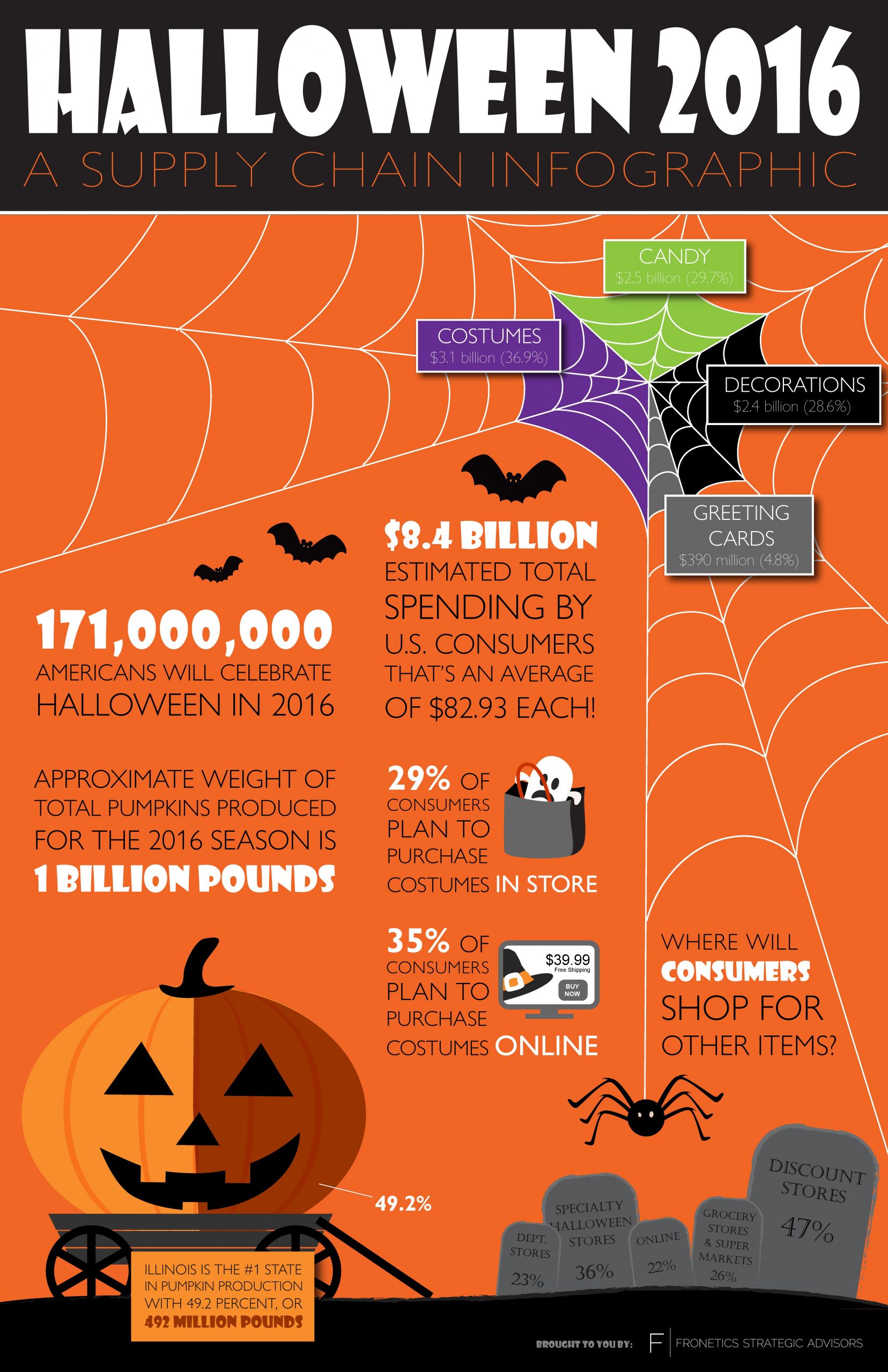
Related posts:
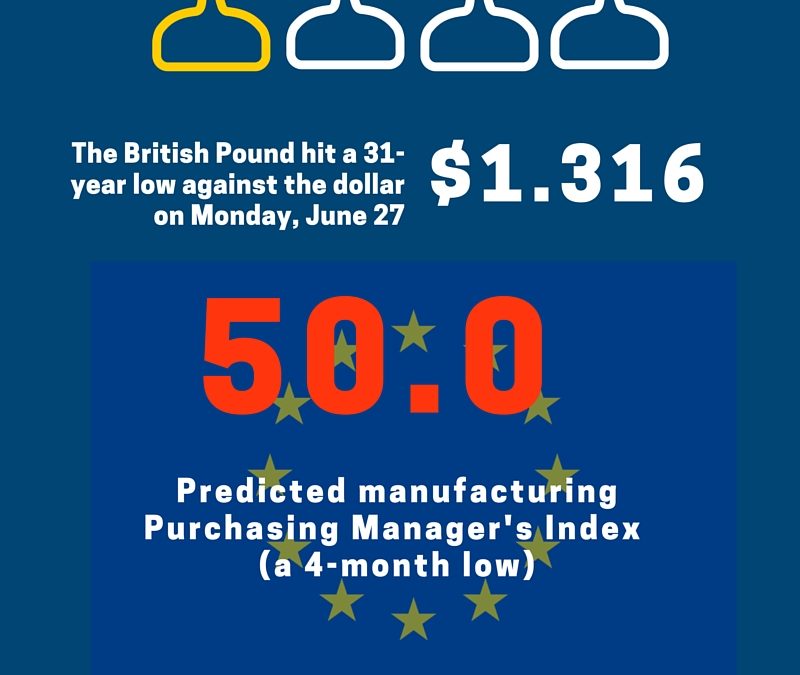
by Fronetics | Jun 30, 2016 | Blog, Current Events, Logistics, Strategy, Supply Chain
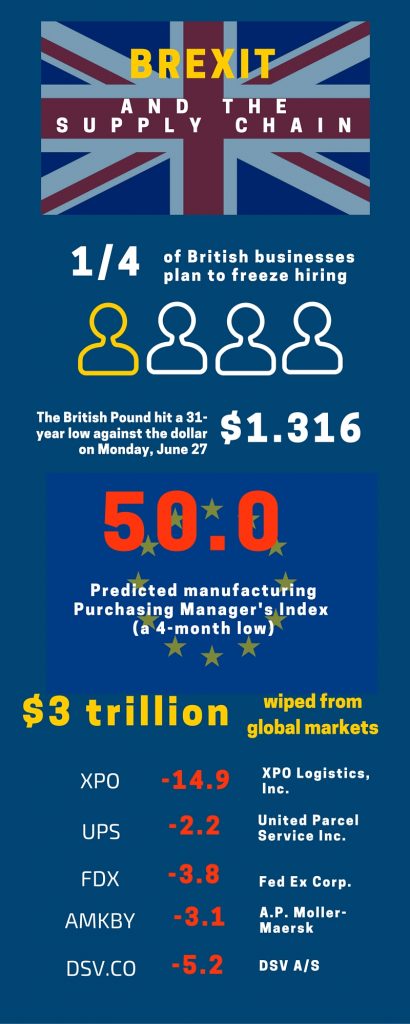 As uncertainty pervades following Brexit, experts speculate about the impact a divorced U.K. and E.U. will have on the global supply chain.
As uncertainty pervades following Brexit, experts speculate about the impact a divorced U.K. and E.U. will have on the global supply chain.
As the Brexit vote roils markets across the globe, uncertainty looms in the air for many businesses. Even U.S.-based organizations without operations or suppliers in Europe are feeling the “significant economic repercussions” of the U.K.’s decision to leave the E.U.
Economists have been scrambling to determine the full impact of the referendum. It seems clear that all aspects of the supply chain will be affected in some way. But we won’t have a clear picture of precisely how prior to the conclusion of the two-year period of negotiation on Britain’s exit terms. Some experts speculate that it could take up to 10 years for new trading relationships with various countries to play out.
For now,“the overriding message for the European logistics and supply chain industry is one of ‘business as usual,’” says Transport Intelligence’s CEO, Prof. John Manners-Bell. “It will be in everyone’s interest to ensure that there is as little disruption to the movement of goods throughout the region as possible.”
In the meantime, here are 8 of the top analyses of Brexit’s impact on the logistics and supply chain industries.
Life after BREXIT: What are the UK’s options outside the European Union? Centre for Economic Performance, London School of Economics and Political Science
Logistics Executives Say Brexit Will Rattle European Supply Chains Wall Street Journal
What Is the Impact of Brexit on My Business? Uncertainty Ripples Through the Supply Chain Forbes
Brexit, the Next Big Disruption for the Supply Chain? Supply Chain 247
Five Models for Post-Brexit UK Trade BBC News
Brexit Wins – What’s Next for the Procurement Industry? Digital Supply Chain
Procurement, Supply Chain and Brexit: Obvious and Less Obvious Considerations Spend Matters
Brexit to Boost U.S. Exports to Asia, Depress Activity to Britain and Europe, Economist Says DC Velocity
Related posts:
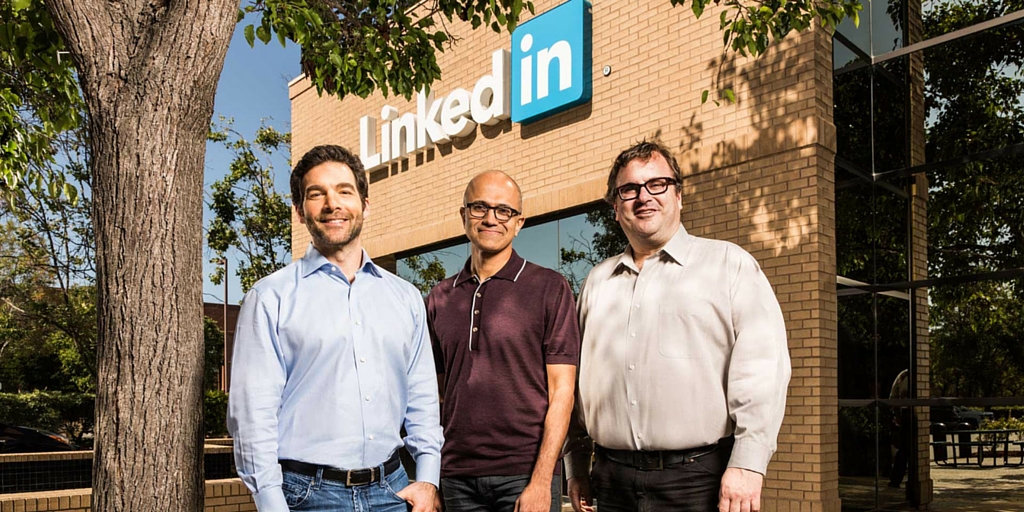
by Fronetics | Jun 20, 2016 | Blog, Current Events, Marketing, Social Media, Strategy

Source: Microsoft
The $26.2-billion acquisition could result in the customer-targeting solution(s) B2B marketers have been waiting for.
Microsoft announced on June 13 that it would purchase LinkedIn for $26.2 billion, a deal set to close by the end of 2016. Though LinkedIn will operate “as a fully independent entity within Microsoft,” the union will strengthen their shared mission to “connect the world’s professionals to make them more productive and successful.”
Both Sadya Nadella and Jeff Weiner’s letters to their employees beam with excitement over the possibilities for product synergies. “Think about it: How people find jobs, build skills, sell, market and get work done and ultimately find success requires a connected professional world,” writes Nadella. “It requires a vibrant network that brings together a professional’s information in LinkedIn’s public network with the information in Office 365 and Dynamics.”
Obvious opportunity lies in enhancing Microsoft’s existing solutions to improve user experience. For example, videos from Lynda.com, a website for training videos that LinkedIn bought in 2015, could be accessible throughout the Office suite, such as an Excel document.
But for B2B marketers, the most exciting possibilities involve “new opportunities … for monetization through individual and organization subscriptions and targeted advertising,” as Nadella puts it.
New opportunities for monetization
Jenny Sussin, a Gartner research director, proposes that LinkedIn’s value to Microsoft lies in its algorithms and user data. Successful integration into Microsoft’s existing products could be a game-changer for the B2B sphere, in terms of targeting customers.
First let’s consider the algorithms, two of which Sussin claims were the main attraction for Microsoft. “No. 1 was the algorithm that creates the connection graph, the social networking graph,” she says. “No. 2 was the algorithm that determines the information most valuable and most actionable to you.” Essentially, with this acquisition, Microsoft has the ability to map how professionals are connected and determine what content is most relevant to each individual user.
Secondly, LinkedIn has the most comprehensive, up-to-date personal data about its 433+ million global users of any professional network. And that data has not been available to other companies — LinkedIn even refused access to Google for ad sales — until now. The value of this information to any B2B organization is indisputable.
Now consider that there are 1.2 billion users of Office and 4.4 million users of Dynamics CRM. Microsoft can now combine the information it knows about those professionals with LinkedIn’s user data, map their relationships, and offer customized content within these products. Imagine being able to reach your target customer within the very tools s/he uses most every day.
And those are just two of Microsoft’s products. Skype, Yammer, MSN: there is no shortage of targeted advertising opportunities.
Taking on Google?
Perhaps the most exciting of these secondary properties for B2B marketers is Bing, Microsoft’s search engine. Bing Ads are attractive to marketers because of the low cost per conversion. The problem, of course, is volume, as Google dominates the market share.
But with LinkedIn’s data and algorithms, Bing could become “what search is sorely lacking today for B2B targeting,” says Marketing Mojo CEO Janet Driscoll Miller.
“Search marketing is great for determining intent — for understanding what a person wants,” Miller explains. “But social media platforms, like LinkedIn, tell us who the person is. Marrying the two pieces of data — who and what — brings us to the sweet spot of marketing and targeting an ideal audience. LinkedIn provides us with demographic targeting based on business and professional user information.”
Targeting could include factors like company size (e.g., spending capabilities), so marketers would not waste impression dollars advertising products that are far beyond the buyer’s price point. Fold in other LinkedIn solutions, like Lead Accelerator, to improve retargeting, and Bing Ads could really compete.
Google may have a leg up in terms of search volume, but without detailed data on users’ professional demographics, Bing could corner the market as the most effective B2B ad targeting platform.
Cause for caution
While the marriage of LinkedIn and Microsoft’s capabilities shows great promise, hold off on celebrating just yet.
Part of LinkedIn’s value to Microsoft derives from user-provided information. And part of Microsoft’s value to B2B marketers lies in its products’ ubiquity. But what if people stopped contributing their personal details to LinkedIn because of the way it was being used across the Microsoft suite? And what if businesses stopped using Microsoft products over privacy or data security concerns?
Here’s why those are both real concerns: Nadella suggests that your LinkedIn newsfeed could show relevant articles based on the projects you’re working on offline. Taking information from my desktop?! That’s problematic from both a personal and proprietary standpoint. Issues around invasion of privacy and the breech of secure business information could present major roadblocks to success.
How would you feel if a software product you researched yesterday appeared in your Outlook today? If, while preparing a PowerPoint for a client meeting, a pop-up suggested you contact a connection in your LinkedIn network who is an expert on the topic? With the deal projected to close before the end of the year, users reactions to these concerns over the next few months could be telling.
Related posts:

by Fronetics | Feb 22, 2016 | Blog, Content Marketing, Current Events, Marketing, Strategy
Content marketing grew one real estate marketing firm’s sales by 300% in less than a year.

Consumers are increasingly going online to conduct research before making a purchase. And that holds true for even the largest investments.
The National Association of Realtors reports that a whopping 94% of Millennials who recently purchased a home relied on websites in their search process. And that’s not just a generational phenomenon — the majority of Baby Boomers (84%) and 69 to 89 year olds (65%) did online research while seeking a new home as well.
Real estate marketers have an enormous opportunity to get their properties in front of more potential buyers through content marketing. With an inbound marketing strategy, customers who are looking for a property like yours will come to you through their own online research.
Take, for example, this case study about a prominent real estate marketing firm in one of the most competitive markets in the U.S. When traditional tactics weren’t bringing in the kind of business needed to sell 1,500 new-construction homes in a new planned community, the firm turned to a new content marketing program to increase web traffic and build brand awareness.
The results were almost immediate. The new digital and content marketing efforts drastically increased web traffic, conversions, and sales. In just 90 days, sales had increased by 37%, and in less than a year, a whopping 300%. At least one-fifth of buyers were sourced directly from the website.
Download this case study to learn more about how content marketing helped the real estate marketing firm drive traffic to their website and increase sales.


by Fronetics | Jan 19, 2016 | Blog, Current Events, Strategy, Supply Chain
The supply chain should prepare for future changes in the wake of the Paris Climate Agreement.
 The 2015 Paris United Nations Climate Change Conference of the Parties (COP) was the 21st yearly meeting of its kind. It drew attention, coming off the heels of the Paris attacks. It also garnered attention because of growing concerns about storms and flooding, ice caps melting, and increasing temperatures. The twelve-day conference hosted 185 nations, and ended with major outcomes that will certainly have an impact on how supply chains will do business.
The 2015 Paris United Nations Climate Change Conference of the Parties (COP) was the 21st yearly meeting of its kind. It drew attention, coming off the heels of the Paris attacks. It also garnered attention because of growing concerns about storms and flooding, ice caps melting, and increasing temperatures. The twelve-day conference hosted 185 nations, and ended with major outcomes that will certainly have an impact on how supply chains will do business.
The biggest outcome from the talks is the agreement to reduce the world’s greenhouse gases significantly to keep temperatures from rising 2 degrees Celsius, and a longer-term agreement to reach net-zero emissions by the second half of the century. If this goal isn’t met, it could bring terrible outcomes globally, such as the loss of entire island nations that could go completely underwater.
Even if the goal is met, there are concerns about the irreversible damage that has been done in the past decades, which indicates the necessity of the plan. The agreement is described as, “probably the most important international agreement in history” by UN Executive Director Achim Steiner.
According to Adrian Gonzalez, president of Boston-based Adelante SCM, “It’s too soon to know what impact this will have on supply chain in the near term, but considering that the agreement is voluntary and there are no enforcement mechanisms in place, my sense is that very little will change over the next twelve months.”
Here are some things supply chain companies need to be considering in the wake of the Paris Climate Agreement, despite the future being unclear:
Assessment
According to James Allan, head of environment and climate change at risk analysis company Versik Maplecroft, “Many companies will have difficulty understanding their exposure to various climate risks, so they may need to bring new skillsets into the organisation, conduct internal studies, and update policies and internal processes.” This might be a new endeavor for companies, or one that wasn’t high on the priority list in the past.
Integration
Allan goes on to say, “A key step will be integrating climate change risks into strategic decision-making and operational risk-management processes.” We will have to wait to see what our congress decides in regards to making the Paris Agreement guidelines into law in the United States. Based on the requirements, companies may have many changes to implement into their business practices.
Partnering
Assessing how partners manage risk and plan to make changes is important, as companies will want to be on the same page. Forming new partnerships with others might also be crucial, particularly if those companies are ahead of the curve on environmental compliance. “Partnerships will also be crucial for successfully managing climate risks, including with supply chain partners, governments, business partners, civil society and the wider public,” says Allan.
We will see what comes from the Paris Climate Agreement and what it has in store for the supply chain and, on a larger scale, the world.
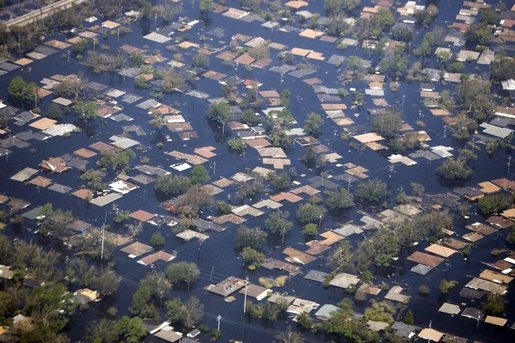
by Fronetics | Jul 22, 2015 | Blog, Current Events, Strategy, Supply Chain

We are increasingly seeing the impact of climate change. We are seeing the impact in the form of drought, wildfires, hurricanes, fires, rising sea-levels, record blizzards, and high temperatures.
The supply chain plays a significant role in climate change. Specifically, there is: damage to the ecosystem caused by industrial and commercial progress in the form of carbon emissions, improper waste removal, energy consumption, and fossil fuel extraction and processing. This damage comes full circle and poses ethical issues regarding business practices for those in the supply chain, and it also impacts business procedures when a climate-driven disaster occurs, such as flooding, drought, and hurricanes. Goods get damaged, deliveries are canceled or delayed, raw materials become inaccessible, energy sources become scarce. With one calamity alone, these can be billion dollar problems. Although overall financial losses from climate-based, weather-related disasters are difficult to measure on a global scale, according to the Intergovernmental Panel on Climate Change, “aggregate losses across the world economy have a more than 50 percent chance of being greater than 2 percent of global GDP.”
The Carbon Disclosure Project reported on a survey of more than 2,000 companies and found that “44 percent of them had suffered a disruption in production from rainfall or drought and 31 percent had experienced higher production costs.” A 2007 study led by the Organization for Economic Co-operation and Development (OECD) estimated that by 2070, seven of the ten greatest urban concentrations of economic assets that are exposed to coastal flooding will be in the developing world; none was in 2005. Assets exposed to such flooding will rise from 5% of world GDP to 9%.
In 2010, Russia’s severe heat wave caused a massive drought and spurred wild fires, ruining a huge swath of wheat crops. The losses were estimated to be $15 billion U.S. dollars. The world-wide impact was huge, as Russia’s exports were limited and global prices increased. In 2011, Thailand experienced some of the worst flooding it had ever seen. The death toll was nearly 900 people and financial losses were estimated at $5.7 billion U.S. dollars. When Superstorm Sandy hit the east coast in 2012 it caused devastating losses. The death toll was 72 and the financial toll was estimated to be in the tens-of-billions, up to $50 billion dollars. The supply chain was badly hit, especially for companies like FedEx, CSX, and many retail companies. Understandably, only Home Depot benefited from the disaster. Year after year we see huge human and financial losses, and incredible disruption to the supply chain.
Acclimatise CEO, John Firth, explains the reaction in the supply chain when disaster strikes, and the need for preparation and awareness of companies, “Pakistan’s 2010 floods caused rice production to fall, increasing crop prices. This prompted consumers to buy wheat, which increased the price of that commodity, and, in turn, the price of cookies in the U.K. In addition to identifying categories that are directly exposed, managers should think about the impacts caused by changes in the markets of substitutes.”
Companies have always had to manage supply and demand risks and supply chain disruption, but a new era is upon us. According to a PWC journal on climate change and supply chain risk, the author states, “the other major factor set to exacerbate supply-chain risk is climate change. Often overlooked, climate change adds to complexity. It amplifies or alters existing risks, for example raw material availability (e.g. water, energy) or transport disruption due to extreme weather events. The resulting shocks on the global supply chain can be severe and persistent.”
Many companies are readying themselves for disaster, and some are fighting back, and trying to reverse some of the damage to the climate.
Fronetics Strategic Advisors is a leading management consulting firm. Our firm works with companies to identify and execute strategies for growth and value creation.
Whether it is a wholesale food distributor seeking guidance on how to define and execute corporate strategy; a telematics firm needing high quality content on a consistent basis; a real estate firm looking for a marketing partner; or a supply chain firm in need of interim management, our clients rely on Fronetics to help them navigate through critical junctures, meet their toughest challenges, and take advantage of opportunities. We deliver high-impact results.
We advise and work with companies on their most critical issues and opportunities: strategy, marketing, organization, talent acquisition, performance management, and M&A support.
We have deep expertise and a proven track record in a broad range of industries including: supply chain, real estate, software, and logistics.





 As uncertainty pervades following Brexit, experts speculate about the impact a divorced U.K. and E.U. will have on the global supply chain.
As uncertainty pervades following Brexit, experts speculate about the impact a divorced U.K. and E.U. will have on the global supply chain.






